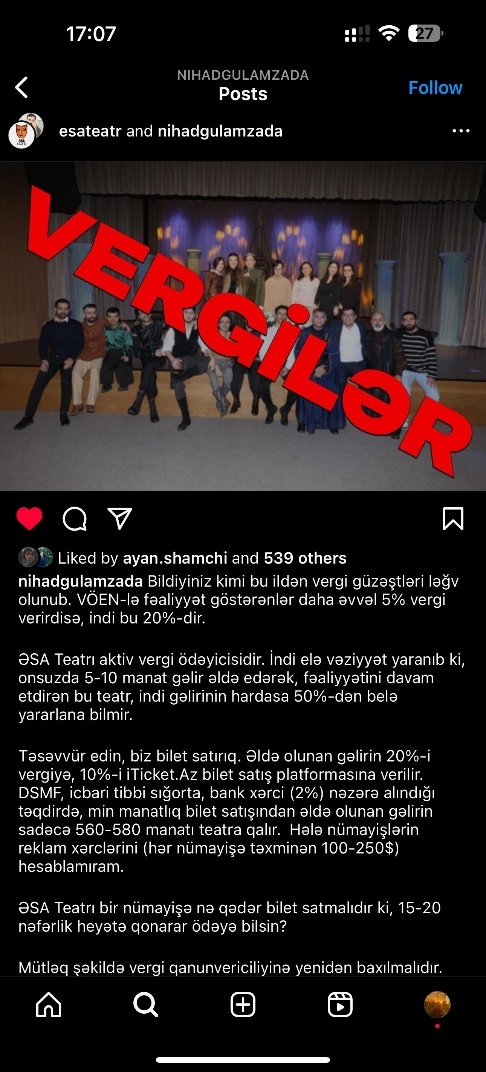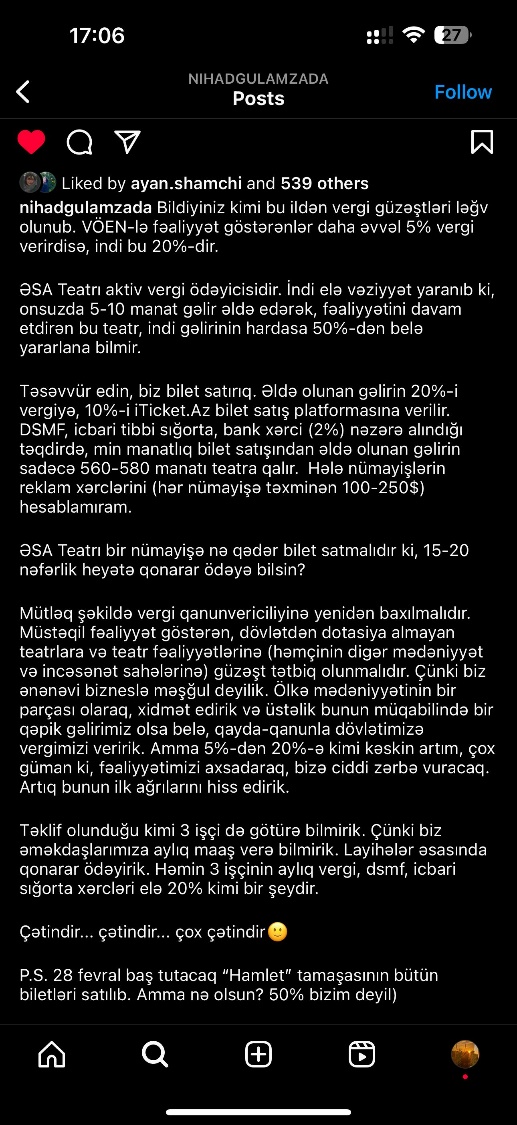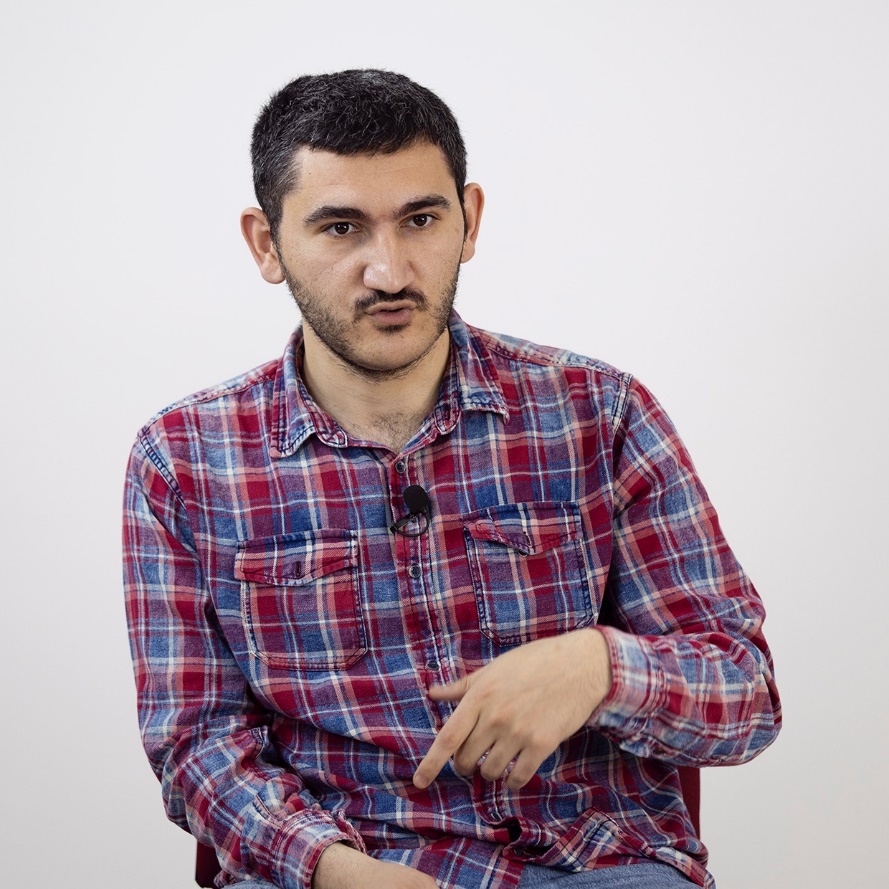
In recent times, independent artists in Azerbaijan are facing a daunting challenge: the scarcity of space. Whether it's financial constraints, lack of suitable venues, or bureaucratic hurdles, artists like Elvin Adigozal and Aynur Zarintaj find themselves grappling with obstacles that hinder their creative expression.
Elvin Adigozal, a prominent figure in the Azerbaijani art scene, recently lamented the difficulty of securing a venue for his stage production "Treasurer." Despite efforts to engage with theater authorities and former directors, Adigozal found himself hitting a wall. The closure of state theaters to independent artists further exacerbates this issue, leaving many talented individuals without a platform to showcase their work.
Similarly, Aynur Zarintaj, the founder of the Ritual Mobile Theater Laboratory, highlights the challenges her theater group faces due to the lack of a dedicated space. Operating primarily online since 2020, Zarintaj emphasizes the necessity of individualized spaces for their therapeutic and social-focused performances. While offers to share spaces have been extended, they often do not align with the specific requirements of their productions, leaving the theater group in a precarious position.


Furthermore, the financial burden imposed by taxes adds another layer of complexity to the situation. Zarintaj raises concerns about the viability of selling tickets when faced with a 20 percent tax on performance revenue. The uncertainty surrounding potential earnings versus production costs creates a dilemma for artists, forcing them to weigh the financial risks against their artistic aspirations.
The spatial constraints not only hinder artistic endeavors but also have broader implications for the cultural landscape of Azerbaijan. Without adequate venues and support structures, independent artists struggle to thrive, depriving the public of diverse artistic experiences and stifling creative innovation.
As Zarintaj eloquently puts it, "The artist also does not know whether to focus on art or tire his brain on other things." This sentiment captures the essence of the predicament faced by independent artists – torn between their passion for art and the harsh realities of survival in an unforgiving landscape.
Lawyer Subhan Hasanli Delves into the Challenges Facing Independent Artists
 In the midst of the spatial and financial quandaries plaguing independent artists in Azerbaijan, lawyer Subhan Hasanli emerges as a beacon of clarity, shedding light on the legal intricacies that underpin these issues. Drawing upon the foundational principles enshrined in the law on culture, Hasanli elucidates the rights and freedoms afforded to artists and the obligations incumbent upon the state.
In the midst of the spatial and financial quandaries plaguing independent artists in Azerbaijan, lawyer Subhan Hasanli emerges as a beacon of clarity, shedding light on the legal intricacies that underpin these issues. Drawing upon the foundational principles enshrined in the law on culture, Hasanli elucidates the rights and freedoms afforded to artists and the obligations incumbent upon the state.
At the crux of Hasanli's elucidation lies the principle of equality and democratism, a cornerstone of cultural legislation in Azerbaijan. This principle, as articulated by Hasanli, underscores the imperative of recognizing and upholding the creative rights of all individuals, irrespective of their political, religious, or other affiliations. Hasanli astutely points out that this principle, enshrined both in the Constitution and the law on culture, extends beyond mere recognition to encompass the expansion of rights and freedoms within the cultural sphere.
In essence, Hasanli contends that the state has a duty to foster an environment conducive to free thinking and creativity, wherein the emergence of new cultural organizations is not only facilitated but actively encouraged. Any attempt to curtail or discriminate against individuals within the cultural realm, Hasanli asserts, runs counter to the fundamental tenets of equality and democratism espoused by Azerbaijani law and its international commitments.
Indeed, Hasanli's insights serve as a poignant reminder of the pivotal role that the legal framework plays in shaping the cultural landscape of Azerbaijan. By grounding his analysis in legal principles, Hasanli provides a nuanced understanding of the challenges faced by independent artists and the responsibilities incumbent upon the state to address these challenges.
As independent artists continue to navigate the complexities of spatial and financial constraints, Hasanli's clarion call for adherence to legal principles offers a glimmer of hope amidst the uncertainty. Through his impassioned advocacy for equality and democratism within the cultural sphere, Hasanli paves the way for a more inclusive and vibrant artistic community in Azerbaijan.
Lawyer Subhan Hasanli Raises Concerns Over Broad Prohibitions in Cultural Legislation
In the labyrinthine realm of Azerbaijani cultural legislation, lawyer Subhan Hasanli emerges as a voice of caution, highlighting the perils posed by overly broad prohibitions and vague language. Hasanli's astute observations shed light on the challenges faced by artists seeking to navigate the legal landscape while pursuing their creative endeavors.
Central to Hasanli's critique is the expansive scope of prohibitions delineated within the law, which he argues can have far-reaching implications for artists across various cultural domains. Drawing attention to article 43 of the Law on Culture as a case in point, Hasanli underscores the sweeping nature of its proscriptions, which encompass calls for generational superiority, social, racial, national, and religious propaganda.
In Hasanli's estimation, the absence of clear parameters defining the boundaries of these prohibitions leaves artists vulnerable to arbitrary interpretation and enforcement by state authorities. Moreover, Hasanli contends that the nebulous concept of "national interests" further compounds the uncertainty surrounding permissible artistic expression. Without explicit criteria elucidating the contours of national interests, artists find themselves navigating treacherous terrain, unsure of where the boundaries lie.
The ramifications of these broad prohibitions extend beyond mere regulatory hurdles; they impede artists' ability to obtain necessary permissions and secure financial support from the state. Hasanli elucidates how films exploring themes such as intergenerational conflict or societal differences may run afoul of these prohibitions, thereby stymying artists' creative pursuits and inhibiting the diversity of cultural expression.
At its core, Hasanli's critique underscores the delicate balance between safeguarding national interests and preserving artistic freedom. While acknowledging the importance of protecting societal cohesion and integrity, Hasanli cautions against the stifling of creative expression in the name of state control. By relegating the cultural sphere to a realm strictly controlled by the state, Hasanli contends, Azerbaijan risks stifling innovation and cultural vibrancy.
In conclusion, lawyer Subhan Hasanli's critique of broad prohibitions within Azerbaijani cultural legislation serves as a sobering reminder of the complexities inherent in balancing state control with artistic freedom. As artists grapple with regulatory constraints and bureaucratic hurdles, Hasanli's advocacy for greater clarity and precision in legal language resonates as a clarion call for reform. Ultimately, the quest for a vibrant and inclusive cultural landscape demands a nuanced approach that prioritizes both the protection of national interests and the promotion of artistic innovation.
Addressing Disparities Among Artists Through Legal Reforms
In the multifaceted realm of artistry, a glaring chasm has emerged, deepened by financial constraints and regulatory hurdles that disproportionately affect independent artists. Subhan Hasanli, a legal luminary, shines a spotlight on the structural inequities ingrained within Azerbaijani cultural legislation, offering insights into the systemic barriers hindering artistic expression and innovation.
At the heart of Hasanli's analysis lies the issue of funding—or rather, the lack thereof—that serves as a formidable impediment to independent artists. Drawing upon the legal framework governing financial allocations, Hasanli delineates the myriad challenges confronting artists seeking financial support. In particular, Hasanli underscores the importance of a robust ecosystem wherein municipalities play a pivotal role in allocating resources from the local budget to support artistic endeavors. However, the inadequate functioning and budgetary constraints of local municipal structures present a formidable obstacle to the realization of this vision.
Moreover, Hasanli sheds light on the arduous process of establishing and operating non-governmental organizations (NGOs) in Azerbaijan, which serves as an alternative avenue for cultural investment. Regulatory hurdles imposed by the Ministry of Justice stifle the formation of NGOs, thereby impeding access to grants and funding from international sources. This stifling regulatory environment not only hampers the growth of the cultural sector but also undermines Azerbaijan's standing within the international community.
Hasanli advocates for a paradigm shift wherein the cultural landscape is not dictated by state intervention but rather regulated by market forces and private entities. By relinquishing control over cultural activities, Hasanli argues, the state can mitigate the polarization and discrimination that often plague the artistic community. However, he acknowledges that systemic reforms are imperative to realize this vision, necessitating amendments to existing laws and the adoption of artist-centric approaches.
In essence, Hasanli's impassioned plea for legal reforms resonates as a clarion call for justice and equity within Azerbaijan's cultural sphere. As artists continue to navigate the labyrinthine landscape of regulatory constraints and financial barriers, Hasanli's advocacy serves as a beacon of hope, illuminating a path toward a more inclusive and vibrant artistic community.













Leave a review